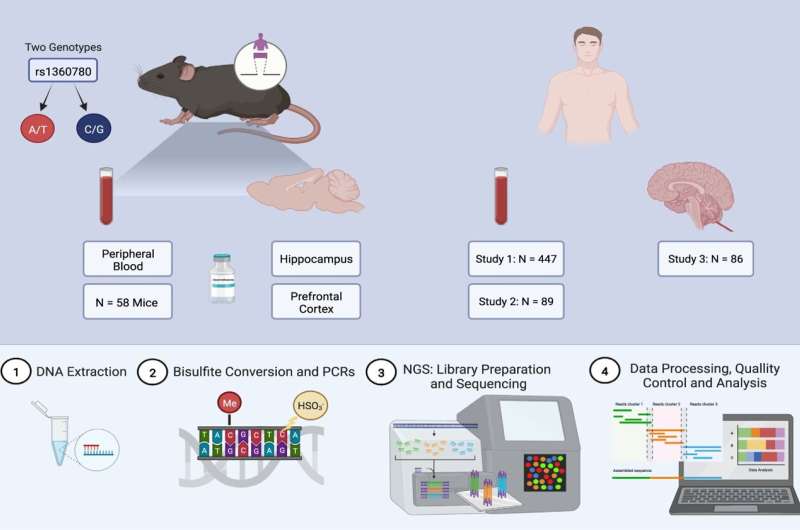This article has been reviewed according to Science X's editorial process and policies. Editors have highlighted the following attributes while ensuring the content's credibility:
fact-checked
trusted source
proofread
Insights into epigenetics: The humanized FKBP5 mouse as a model organism

The candidate gene FKBP5 is involved in the development of stress-related psychiatric disorders. A few years ago, researchers at the MPI discovered that it is increasingly activated in the brains of patients and can permanently alter the stress response. It therefore makes sense to develop a therapeutic approach that blocks this gene.
To do this, however, it is crucial to know which areas of the brain or even which cell types could be potential targets for intervention. A corresponding measurement in human brain tissue after activation of the stress system is not yet possible.
The MPI team has chosen the humanized mouse as a model organism for its investigations. In these animals, the existing mouse gene was exchanged for the human FKBP5 gene. The results that the researchers obtained from mice were compared with data that they were able to obtain from human brains and blood.
Epigenetics is crucial
Epigenetic changes are a key mechanism for the regulation of genes. They are caused by environmental influences, among other things. Stress, exercise, diet and much more have an effect on whether individual genes are activated or not. This results in so-called methylation patterns on certain sections of the DNA.
Due to the limited similarity of the non-coding DNA sections in the normal mouse model, it is difficult to investigate such mechanisms, which are known from human research. The humanized FKBP5 mouse model could represent an advantage, but the epigenetics of this model were not previously known. MPI scientists have now investigated the patterns of DNA methylation of the FKBP5 gene in the humanized mouse model and compared them with those of humans.
They were able to provide evidence that when the human FKBP5 gene is transferred into the mouse, the epigenetic patterns, especially in the brain, are also transferred: The methylation patterns seen in the mice resembled those of humans.
"This makes the humanized FKBP5 mouse suitable as a model organism to further investigate and specifically modulate stress-associated biological mechanisms in the brain," says Natan Yusupov, the first author of the study published in Molecular Psychiatry.
Together with his colleagues, he now also wants to find out in which brain regions the candidate gene FKBP5 is increasingly transcribed and whether there are cell type-specific differences.
Looking toward the future, MPI Director Elisabeth Binder states, "We will continue to research the molecular biological mechanisms so that, ideally, an FKBP5 blocker can be used therapeutically at some point."
More information: Natan Yusupov et al, DNA methylation patterns of FKBP5 regulatory regions in brain and blood of humanized mice and humans, Molecular Psychiatry (2024). DOI: 10.1038/s41380-024-02430-x





















